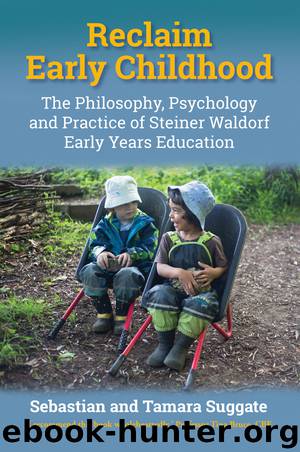Reclaim Early Childhood by Sebastian Suggate

Author:Sebastian Suggate
Language: eng
Format: epub
Publisher: Hawthorn Press
6.3.3 Language
The ability to use language is a uniquely human activity that not only allows communication, but imbues and suffuses our surroundings with culture, soul, melody and aesthetic mood. Conversely, language that is dry, abstract and relentless works in a parching way on the environment. For this reason, the type of language and when it is employed constitute a cornerstone of Steiner education.
Depending on the culture but especially in English, language today has a tendency to become abstract, which makes it difficult for children to relate to. One property of abstract language is the inundation of technical terms that have lost their connection to the morphemes comprising the word. This is particularly evident in the English academic penchant for Latin words, or in the increasing introduction of English words into many languages, which replaces original words that have naturally evolved from constituent parts (i.e. morphemes) in those languages.
Another feature of abstract language is the tendency to name everything (e.g. ‘Look, that is called an “aviary”’), as opposed to more characterizing evocations (e.g. ‘Imagine living in that bird house!’). A characteristic or adjective, when well chosen, evokes a feeling, and alludes to the nature of things, whereas a substantive (i.e. a noun) often does not invoke the same curiosity. Of course adjectives can also be judgmental and basal, such as overuse of words like ‘ugly’ or ‘silly’. Interestingly, it is often dialects that capture this more living, soul quality, such as when in Cockney a hammer is referred to as a ‘jimmy jammer’.
In addition, a living language need not be artificially simplified for children and conveyed in a patronizing tone, as if the child is half-deaf and intellectually sub-par. It is far better to speak in an authentic way (‘I’ sense; see section 4.4.4 and also section 6.6.1), leaving children to utilize their speech and thought senses to extract the meaning and its essence, and their extraordinary imitation abilities to absorb the word.
Through verses, rhymes, finger games, songs and stories, in Waldorf-Steiner kindergartens a particular emphasis is placed on language and music. Be it during circle-time or story-time, or simply during transition phases, attention is given to the rhythmic, poetic elements of language. Basic word-games may also be employed. Indeed, a full and pictorial use of language in a nuanced and conscious fashion can provide teachers with opportunities to enlighten, to comfort, to use humour and to allude to the wonders of the surrounding world. In particular, when combined with music and rituals, a thoughtful use of language has the ability to create an especially calming, aesthetically rich environment.
Most Steiner kindergartens also perform puppet shows, as well as finger games and songs accompanied by gestures. The focus on the aesthetic and rhythmic nature of language allows even non-native speakers to gradually acquire the new language, particularly in terms of the rhythmical (phonetic and prosodic) and semantic (meaning) aspects of the language, but also its structure (grammar) and pragmatics (contextual meaning).
Story-telling, sometimes in the form of a free rendering, is also important in Waldorf-Steiner kindergartens.
Download
This site does not store any files on its server. We only index and link to content provided by other sites. Please contact the content providers to delete copyright contents if any and email us, we'll remove relevant links or contents immediately.
| Administration | Assessment |
| Educational Psychology | Experimental Methods |
| History | Language Experience Approach |
| Philosophy & Social Aspects | Reform & Policy |
| Research |
The Art of Coaching Workbook by Elena Aguilar(48065)
Trainspotting by Irvine Welsh(20055)
Twilight of the Idols With the Antichrist and Ecce Homo by Friedrich Nietzsche(17707)
Fangirl by Rainbow Rowell(7834)
Periodization Training for Sports by Tudor Bompa(7328)
Change Your Questions, Change Your Life by Marilee Adams(6641)
This Is How You Lose Her by Junot Diaz(5773)
Grit by Angela Duckworth(4738)
Red Sparrow by Jason Matthews(4668)
Asking the Right Questions: A Guide to Critical Thinking by M. Neil Browne & Stuart M. Keeley(4576)
Paper Towns by Green John(4169)
Room 212 by Kate Stewart(4107)
Ken Follett - World without end by Ken Follett(3973)
The Sports Rules Book by Human Kinetics(3588)
Housekeeping by Marilynne Robinson(3401)
The Motorcycle Diaries by Ernesto Che Guevara(3333)
Introduction to Kinesiology by Shirl J. Hoffman(3301)
Exercise Technique Manual for Resistance Training by National Strength & Conditioning Association(3292)
Double Down (Diary of a Wimpy Kid Book 11) by Jeff Kinney(3273)
